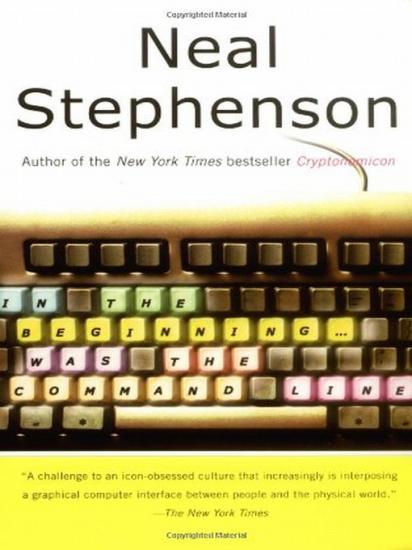
Rating: ****
Tags: Computers, General, Lang:en
Summary
This is "the Word" -- one man's word, certainly -- about
the art (and artifice) of the state of our computer-centric
existence. And considering that the "one man" is Neal
Stephenson, "the hacker Hemingway" (
Newsweek) -- acclaimed novelist, pragmatist, seer,
nerd-friendly philosopher, and nationally bestselling author
of groundbreaking literary works (
Snow Crash, Cryptonomicon, etc., etc.) -- the word
is well worth hearing. Mostly well-reasoned examination and
partial rant, Stephenson's
In the Beginning... was the Command Line is a
thoughtful, irreverent, hilarious treatise on the
cyber-culture past and present; on operating system tyrannies
and downloaded popular revolutions; on the Internet, Disney
World, Big Bangs, not to mention the meaning of life
itself. ** Neal Stephenson, author of the sprawling and engaging
Cryptonomicon, has written a manifesto that could be
spoken by a character from that brilliant book. Primarily,
In the Beginning ... Was the Command Line discusses
the past and future of personal computer operating systems.
"It is the fate of manufactured goods to slowly and gently
depreciate as they get old," he writes, "but it is the fate
of operating systems to become free." While others in the
computer industry express similarly dogmatic statements,
Stephenson charms the reader into his way of thinking,
providing anecdotes and examples that turn the pages for
you. Stephenson is a techie, and he's writing for an audience
of coders and hackers in
Command Line. The idea for this essay began online,
when a shortened version of it was posted on
Slashdot.org. The book still holds some marks of an
e-mail flame gone awry, and some tangents should have been
edited to hone his formidable arguments. But unlike similar
writers who also discuss technical topics, he doesn't write
to exclude; readers who appreciate computing history (like
Dealers of Lightning or
Fire in the Valley) can easily step into this
book. Stephenson tackles many myths about industry giants in
this volume, specifically Apple and Microsoft. By now, every
newspaper reader has heard of Microsoft's overbearing
business practices, but Stephenson cuts to the heart of new
issues for the software giant with a finely sharpened steel
blade. Apple fares only a little better as Stephenson (a
former Mac user himself) highlights the early steps the
company took to prepare for a monopoly within the computer
market--and its surprise when this didn't materialize. Linux
culture gets a thorough--but fair--skewering, and the
strengths of BeOS are touted (although no operating system is
nearly close enough to perfection in Stephenson's eyes). As for the rest of us, who have gladly traded free will
and an intellectual understanding of computers for a
clutter-free, graphically pleasing interface, Stephenson has
thoughts to offer as well. He fully understands the limits
nonprogrammers feel in the face of technology (an example
being the "blinking 12" problem when your VCR resets itself).
Even so, within
Command Line he convincingly encourages us as a
society to examine the metaphors of
technology--simplifications that aren't really much
simpler--that we greedily accept.
--Jennifer Buckendorff
After reading this galvanizing essay, first intended as a
feature for Wired magazine but never published there, readers
are unlikely to look at their laptops in quite the same
mutely complacent way. Stephenson, author of the novel
Cryptonomicon, delivers a spirited commentary on the
aesthetics and cultural import of computer operating systems.
It's less an archeology of early machines than a critique of
what Stephenson feels is the inherent fuzziness of graphical
user interfacesAthe readily intuitable "windows," "desktops"
and "browsers" that we use to talk to our computers. Like
Disney's distortion of complicated historical events, our
operating systems, he argues, lull us into a reductive sense
of reality. Instead of the visual metaphors handed to us by
Apple and Microsoft, Stephenson advocates the purity of the
command line interface, somewhat akin to the DOS prompt from
which most people flee in a technophobic panic. Stephenson is
an advocate of Linux, the hacker-friendly operating system
distributed for free on the Internet, and of BeOS, a
less-hyped paradigm for the bits-and-bytes future. Unlike a
string of source code, this essay is
user-friendlyAoccasionally to a fault. Stephenson's own set
of extended metaphors can get a little hokey: Windows is a
station wagon, while Macs are sleek Euro-sedans. And Unix is
the Gilgamesh epic of the hacker subculture. Nonetheless, by
pointing out how computers define who we are, Stephenson
makes a strong case for elegance and intellectual freedom in
computing. (Nov.)
Amazon.com Review
From Publishers Weekly
Copyright 1999 Reed Business Information,
Inc.